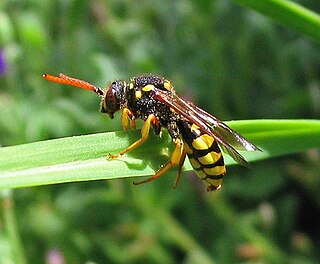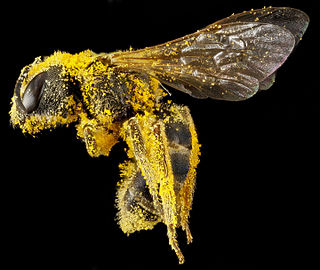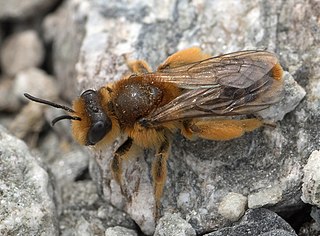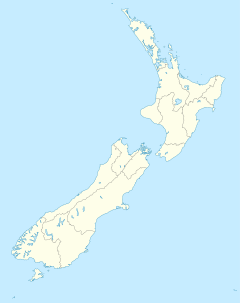
Halictidae is the second-largest family of bees. Halictid species occur all over the world and are usually dark-colored and often metallic in appearance. Several species are all or partly green and a few are red; a number of them have yellow markings, especially the males, which commonly have yellow faces, a pattern widespread among the various families of bees. The family is distinguished by the arcuate basal vein found on the wing.

With over 850 species, the genus Nomada is one of the largest genera in the family Apidae, and the largest genus of kleptoparasitic "cuckoo bees." Kleptoparasitic bees are so named because they enter the nests of a host and lay eggs there, stealing resources that the host has already collected. The name "Nomada" is derived from the Greek word nomas (νομάς), meaning "roaming" or "wandering."

Lasioglossum malachurum, the sharp-collared furrow bee, is a small European halictid bee. This species is obligately eusocial, with queens and workers, though the differences between the castes are not nearly as extreme as in honey bees. Early taxonomists mistakenly assigned the worker females to a different species from the queens. They are small, shiny, mostly black bees with off-white hair bands at the bases of the abdominal segments. L. malachurum is one of the more extensively studied species in the genus Lasioglossum, also known as sweat bees. Researchers have discovered that the eusocial behavior in colonies of L. malachurum varies significantly dependent upon the region of Europe in which each colony is located.

Anthidium manicatum, commonly called the European wool carder bee is a species of bee in the family Megachilidae, the leaf-cutter bees or mason bees.

Colletes hederae, the ivy bee, is a species of plasterer bee belonging to the family Colletidae subfamily Colletinae.

Within the insect order Hymenoptera, the Halictinae are the largest, most diverse, and most recently diverged of the four halictid subfamilies. They comprise over 2400 bee species belonging to the five taxonomic tribes Augochlorini, Thrinchostomini, Caenohalictini, Sphecodini, and Halictini, which some entomologists alternatively organize into the two tribes Augochlorini and Halictini.

Halictus ligatus is a species of sweat bee from the family Halictidae, among the species that mine or burrow into the ground to create their nests. H. ligatus, like Lasioglossum zephyrus, is a primitively eusocial bee species, in which aggression is one of the most influential behaviors for establishing hierarchy within the colony, and H. ligatus exhibits both reproductive division of labor and overlapping generations.

Leioproctus fulvescens is a species of bee native to the South Island of New Zealand. Adults are about 10 mm long with dense characteristically yellow to orange-brown hair; this feature distinguishes them from other New Zealand Leioproctus species, which have white to cream hairs. The bees fly primarily in the spring and summer, with the majority of individuals between November to March, though some have been observed as early as September.

Lasioglossum cressonii is a species in the sweat bee genus Lasioglossum, family Halictidae. Halictidae exhibit eusocial hierarchy behavior which is interesting given that eusociality in this group is hard to evolve and easy to lose. L. cressonii is found throughout North America. L. cressonii have been shown to be important pollinators for apple trees and many other North American native plants. A common name is Cresson's metallic sweat bee.

Lasioglossum hemichalceum, which has sometimes been confused with L. erythrurum, is a sweat bee endemic to Australia. Large numbers of unrelated females will typically share a single nest, a behavior referred to as "communal". Nests are constructed underground by the independent efforts of the females. L. hemichalceum will typically begin creating new colonies during the summer, with brood production from late November through the first few months of spring. Members of this species do not demonstrate aggressive behavior towards one another. As the size of the colony increases, the reproductive potential of each female does not change, unlike many species of bees.
Lasioglossum figueresi, formerly known as Dialictus figueresi, is a solitary sweat bee that is part of the family Halictidae of the order Hymenoptera. Found in Central America, it nests in vertical earthen banks which are normally inhabited by one, though sometimes two or even three, females. Females die before their larvae hatch. It was named after José Figueres Ferrer, a famous Costa Rican patriot, and studies of its behavior are now general models for social behavior studies.
Lasioglossum aeneiventre, also known as Dialictus aeneiventre, is a social sweat bee and is part of the family Halictidae of the order Hymenoptera. Found in Central America, it nests mostly on flat ground though sometimes in vertical banks. It is often compared to L. figueresi.

Lasioglossum leucozonium, also known as Lasioglossum similis, is a widespread solitary sweat bee found in North America, Europe, Asia, and parts of northern Africa. While now a common bee in North America, population genetic analysis has shown that it is actually an introduced species in this region. This population was most likely founded by a single female bee.

Macropis nuda is a ground nesting, univoltine bee native to northern parts of North America. Thus, this species cocoons as pupae and hibernates over the winter. The species is unique as it is an oligolectic bee, foraging mainly for floral oils from Primulaceae of the genus Lysimachia.

Augochlora pura is a solitary sweat bee found primarily in the Eastern United States. It is known for its bright green color and its tendency to forage on a variety of plants. Inhabiting rotting logs, this bee can produce up to three generations per year. Both males and females have been observed licking sweat from human skin, most likely seeking salt

Colletes validus, colloquially known as the blueberry cellophane bee or blueberry polyester bee, is a solitary, specialist bee in the family Colletidae. It is found primarily in eastern North America where it nests in sandy soils near ericaceous plants.

Lasioglossum sordidum, also referred to as the small native bee, is one of the smallest native bees found in New Zealand.
A list of the species of Hymenoptera from New Zealand; currently listing the 'stinging wasps' (Aculeata), which includes ants, bees, and social wasps.

Leioproctus boltoni is a species of bee in the family of plasterer bees. This species was first described in 1904 and is endemic to New Zealand. They are a solitary bee, small and black in appearance. L. boltoni can be found throughout the main islands of New Zealand and forages on the flowers of both native and introduced species of plants. This species nests in the soil with their life cycle lasting approximately a year.
Leioproctus huakiwi is a species of bee in the family Colletidae family. This species was first described in 2007 and is endemic to New Zealand. L. huakiwi is a solitary bee, small and mainly black in appearance. It nests in the ground in bare, dry and fine soil. This species has been the subject of a successful translocation in Canterbury in 2005.


















